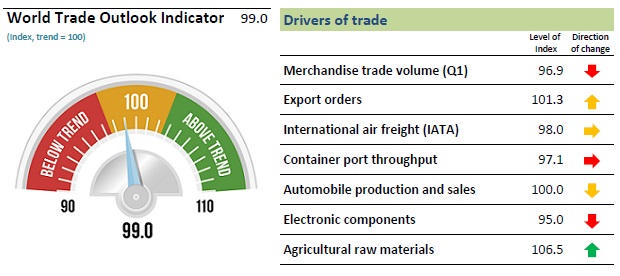News
WTO launches new World Trade Outlook Indicator

The WTO has launched a new World Trade Outlook Indicator (WTOI) designed to provide “real time” information on trends in global trade. The WTOI was unveiled in Shanghai, China on 8 July, ahead of a meeting of G20 trade ministers.
Combining a variety of trade-related indices, the WTOI is designed to give an early signal of the current direction of world trade and where it is likely to go in the near future. In this way the WTOI should signal turning points in world merchandise trade volume. It complements existing tools such as the WTO’s longer-term trade forecasts, and other statistical releases.
The WTOI gives a headline figure to show performance against trend. A reading of 100 would indicate trade growth in line with recent trends, a reading greater than 100 would suggest above trend growth, while a reading below 100 indicates below trend growth. The WTOI will be updated on a quarterly basis.

Latest data suggest trade growth to remain sluggish into the third quarter
For the current period, the WTOI came in slightly below trend, with a reading of 99.0, and with a downward tendency in the most recent data, signalling that trade growth will continue to be sluggish in July and August.
WTO Director-General Roberto Azevêdo said:
“In serving as a quarterly signal of current and short-term trade conditions, the World Trade Outlook Indicator responds to strong interest from policymakers and the business community for more immediate, real time information on trade and trading conditions. The WTOI should provide an early signal if trade is likely to slow or accelerate in the near future. At present it suggests that trade growth will remain weak into the third quarter of 2016.”
The reading was slightly more positive than that for merchandise trade, which declined in the first quarter 2016, as noted in the WTO’s recent quarterly trade statistics. The WTOI therefore suggests that world merchandise trade may rebound in the second quarter, but that the underlying weakness will persist into the third quarter.
Components of the WTOI give a mixed picture. Export orders in leading traders have rebounded above trend and continue to pick up. Meanwhile, international air freight data from IATA and container throughput data from major seaports remain weak but show signs of stabilizing. Automobile sales and production have fallen back to trend after rising sharply earlier in the year. Electronic components trade has dipped sharply and is losing momentum, while trade in agricultural raw materials trade has picked up.
Background on the methodology
The WTO’s approach in calculating the WTOI is similar to that used in other composite leading indicators (CLIs) and purchasing managers’ indices (PMIs), except that it focuses on six key trade-related indices:
-
Export orders reported by central banks and national statistics agencies in leading manufacturing economies;
-
International freight tonne kilometres reported by the International Air Transport Association (IATA);
-
Total container throughput from a dozen major shipping ports, in twenty-foot equivalent (TEU) units;
-
Automotive vehicle sales and/or production figures in major markets;
-
Customs data on electronic components trade, in physical units; and
-
Customs data on trade flows for agricultural raw materials.
The WTOI uses a technique that separates high frequency fluctuations from the general tendency of a data series to produce a smoothed trend. All data in the WTOI are of monthly frequency and are seasonally adjusted and rebased to 100.
Further details on the methodology are contained in a technical note, available below.




